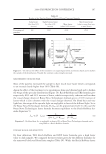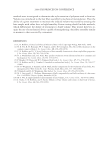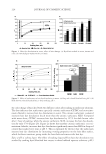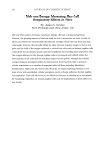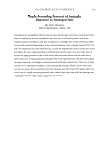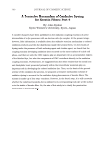J. Cosmet. Sci., 60, 273–280 (March/April 2009) 273 Brazilian oils and butters: The effect of different fatty acid chain composition on human hair physiochemical properties ADRIANA FREGONESI, CARLA SCANAVEZ, LEANDRA SANTOS, AMANDA de OLIVEIRA, ROBERTA ROESLER, CASSIANO ESCUDEIRO, PRISCILA MONCAYO, DAISY de SANCTIS, and JEAN LUC GESZTESI, Natura Inovação e Tecnologia de Produtos– Brazil, Rodovia Anhanguera s/n° km 30.5, Polviho CEP: 07750-000, Cajamar, SP, Brazil. Synopsis This study evaluated the performance of fi ve oils and three butters extracted from Brazilian plants with dif- ferent fatty chain composition on hair mechanical properties, split end formation, combing analysis and gloss measurements. Oil treatment reduced the combing force percentage for wet conditions. However, the hair treated with butters showed poor combing. Except for ucuúba butter, oils and butters used in this work had generally no infl uence on hair tensile properties. In general, hair treated with oils showed a signifi cant gloss increase and a decrease for split end formation. The fatty acid composition of the oils and butters tested showed an effect on the physicochemical properties of hair. INTRODUCTION Vegetal oils have been extensively used by hairdressers around the world as cosmetic treatments for human hair of different ethnic origin. As an example, the prolonged use of coconut oil is claimed to lead to healthy looking long hair, suggesting that oil may pre- vent cuticle cell damage. This behavior is expected due to the lubricating effects of oils on hair fi ber that reduces abrasive damage (1). Another interesting aspect is that the dif- fusion of oils into hair fi ber depends on oil triglyceride composition. Coconut oil is basi- cally composed of lauric chains (C12), therefore, able to penetrate the fi ber. Once inside the hair fi ber, the oil seems to increase protein hydrophobicity and consequently reduces the cuticle swelling effect by water, providing a reduction of the fatigue imposed to the fi ber by successive swelling cycles (2). The layers of cuticle cells form the outer barrier of the hair fi ber and are mainly responsible for the cosmetic properties such as easy combing, gloss and smooth touch. Cuticle cells are susceptible to damage by grooming, weathering and daily care procedures. The loss of cuticle cells is the fi rst step for the formation of split ends and the use of oil and butter may prevent this cuticle damage (3). Hair strength, on the other hand, is attributed to the cortex, which forms the bulk of the fi ber and is re- sponsible for mechanical properties (4).
JOURNAL OF COSMETIC SCIENCE 274 This study evaluated the performance of fi ve oils and three butters extracted from Bra- zilian plants with different fatty chain compositions on hair mechanical properties, split end formation, combing analysis and gloss measurements. The fi ve oils used in this work were passion fruit seeds extract (Passifl ora edulis), Brazilian nuts extract (Bertholletia excelsa), palm olein (a low-melting fraction of palm oil (Elaeis Guineensis)), buriti extract (Mauritia fl exuosa) and palm stearin (the most solid fraction of palm oil (Elaeis Guineensis)). The three butters used in this work were tucumã (Astrocarium tucuma), ucuúba (Virola surinamensis) and sapucainha (Carpotroche brasiliensis). Mineral oil was used as the control. The composition of the fatty acids is described as follows: passion fruit seed (77% linoleic acid), Brazilian nut (38% oleic acid and 35% linoleic acid), palm olein (47% oleic acid), buriti (79% oleic acid), palm stearin (42% palmitic acid and 41% oleic acid), tucumã (48% lauric acid and 27% myristic acid), ucuúba (75% myristic acid), sapucainha (47% chaulmoogric acid, 27% hidnocarpic and 19% gorlic acid). MATERIALS AND METHODS HAIR SAMPLES The tresses of virgin dark-brown and bleached hairs were obtained from De Meo Brothers Inc. (NY, USA). The hair samples were cleaned with lauryl sodium sulfate solution (10 w/v), combed using a polypropylene comb and stored at room temperature prior to use. Hair treatment: 0.5 ml of oil was applied to a 5 g hair tress and rubbed on it for 1 minute. The tresses were then kept in a climate controlled room for 15 minutes before the measure- ments. For dry combing tests the tresses were maintained in a climate controlled room (25 ± 5°C) for 24 h after the measurements in wet condition. TRIGLYCERIDES SAMPLES The samples were extracted from Brazilian plants. The Tucumã, Ucuúba and Sapucainha butters were processed by Natura Inovação e Tecnologia de Produtos Ltda (Brazil). The palm olein and stearin palm were processed in association with Agroplama (Brazil). The passion fruit seed oil was supplied by Croda Brazil, Brazilian nut oil by Cognis Brazil Ltda and buriti oil by Beraca Ingredients (Brazil). MECHANICAL PROPERTIES Mechanical properties of the treated hairs and the reference (hair without treatment) were achieved by stress/strain curves obtained using 50 bleached hair fi bers of each treated hair sample. The analysis was performed by a 4301 Instron Machine using a 10 N load cell at 50 mm/min constant speed. The fi bers were maintained at 25 ± 5°C and 50 ± 5% RH for 24 h prior to the measurements. The diameter of each fi ber was mea- sured after conditioning using a Mitutoyo micrometer. The results were interpreted us- ing the Xlstat software applications with Anova and Turkey statistics tools at 90% confi dence level.
Purchased for the exclusive use of nofirst nolast (unknown) From: SCC Media Library & Resource Center (library.scconline.org)














































































